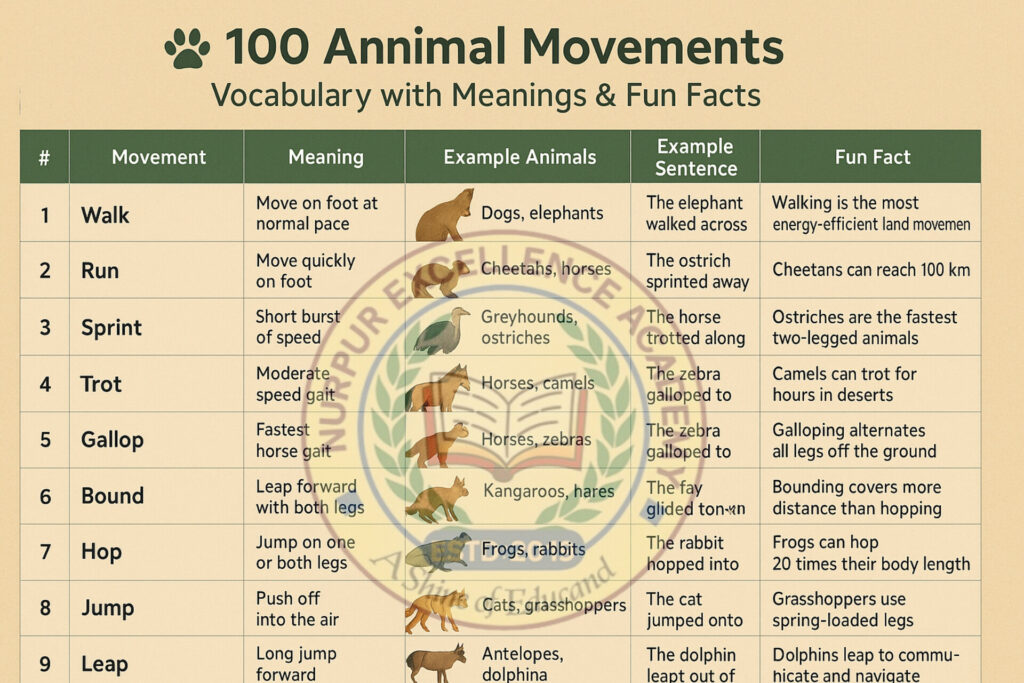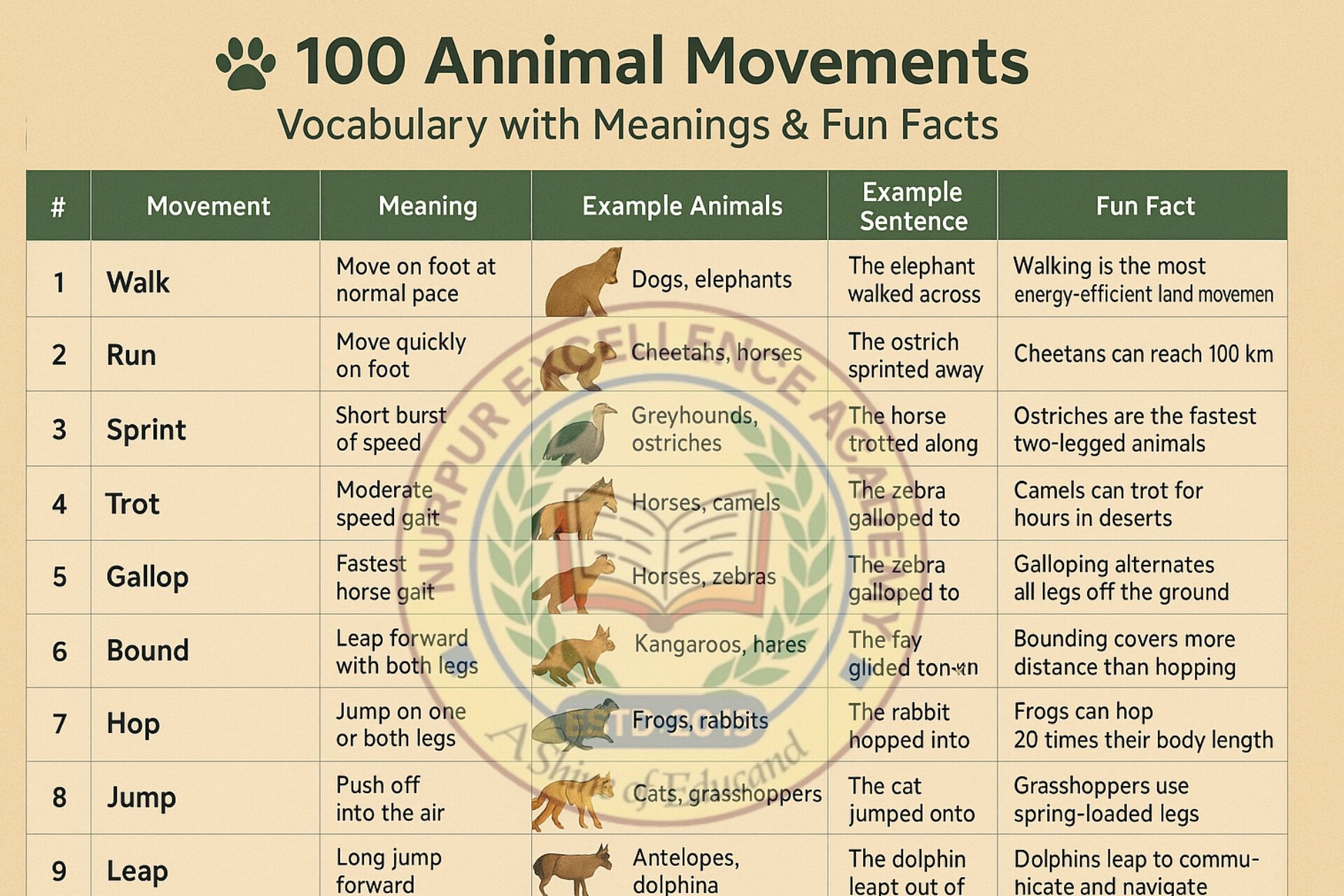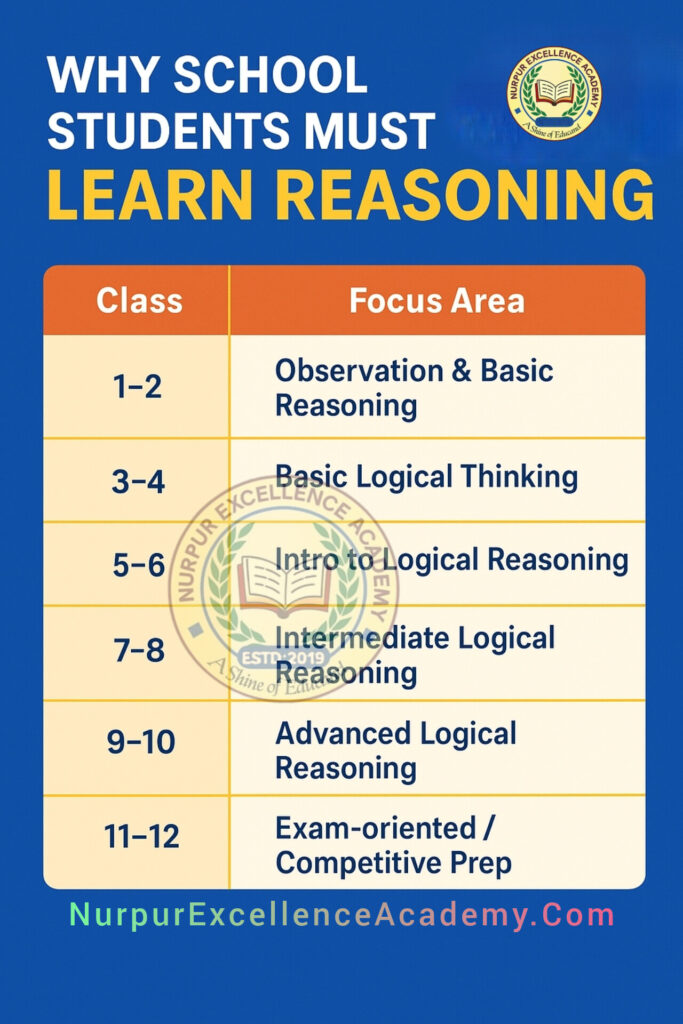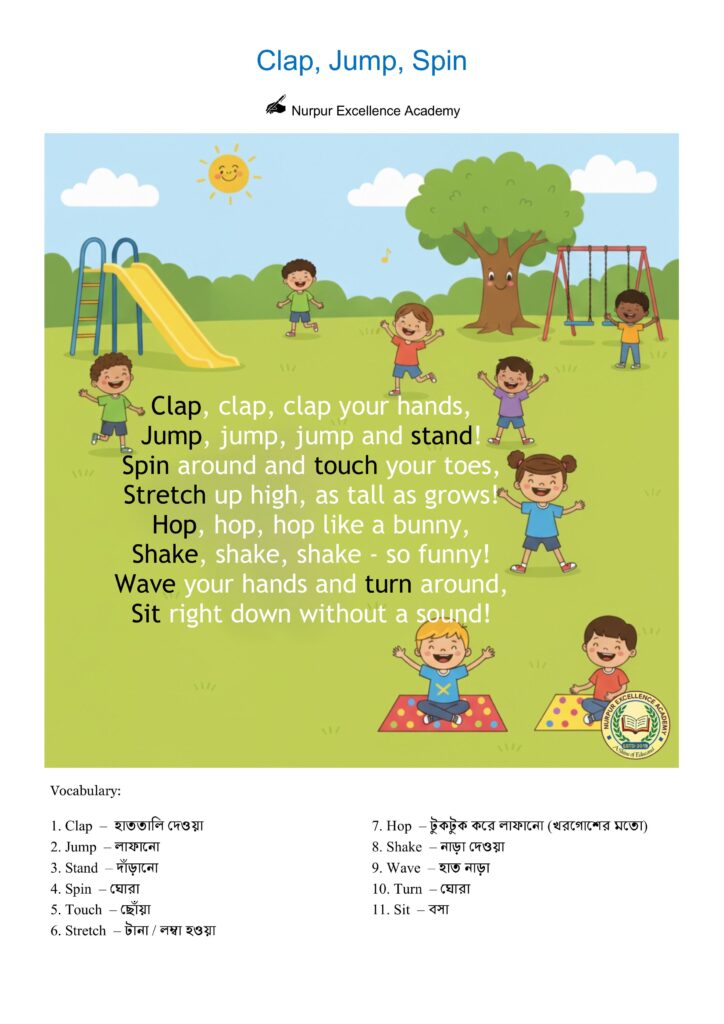Animals don’t just “walk” or “run”—they trot, gallop, slither, flutter, pounce, scamper, and so much more!
Whether you’re a student learning English vocabulary, a teacher preparing ESL lessons, or just an animal enthusiast, knowing the exact words for animal movements makes your writing and speech richer, more accurate, and more fun.
From a cheetah’s dash to an eagle’s swoop, from a snake’s slither to a jellyfish’s drift, we’ve covered movements from every corner of the animal kingdom. And yes — you’ll also learn a fun fact for each!
Here’s the world’s largest free list of 100 animal movement styles, complete with meanings, example animals, example sentences, and fascinating fun facts.
Let’s dive in! 🐕🐈🦅🐇🐍
1–20: Common Land Animal Movements
| Movement | Meaning | Example Animals | Example Sentence | Fun Fact |
|---|---|---|---|---|
| Walk | Move at a steady pace on foot | Humans, elephants | The elephant walked slowly across the plain. | Elephants walk almost silently despite their size. |
| Run | Move quickly on foot | Dogs, deer | The deer ran to escape the predator. | Cheetahs can run up to 120 km/h. |
| Trot | Medium-speed pace between walk and run | Horses, dogs | The puppy trotted beside its owner. | Horses trot in a rhythmic two-beat gait. |
| Gallop | Fastest horse gait | Horses, zebras | The stallion galloped across the field. | Racehorses can gallop at 70 km/h. |
| Canter | Medium-speed horse gait | Horses | The rider enjoyed a gentle canter. | It’s smoother than a trot but slower than a gallop. |
| Bound | Leap forward with both feet | Kangaroos, gazelles | The gazelle bounded away. | Bounding helps cover large distances quickly. |
| Hop | Jump using both legs together | Rabbits, frogs | The rabbit hopped towards the garden. | Kangaroos hop as their main movement. |
| Jump | Push oneself off the ground into the air | Cats, monkeys | The cat jumped onto the wall. | Fleas can jump 100× their height. |
| Leap | Long or high jump | Tigers, frogs | The tiger leaped across the stream. | Leopards can leap over 6 meters. |
| Pounce | Leap suddenly to catch prey | Cats, owls | The cat pounced on the mouse. | Lions use pouncing to surprise prey. |
| Scamper | Run quickly with small steps | Mice, squirrels | The mouse scampered into the hole. | Scampering is often a sign of fear. |
| Scurry | Move quickly and hurriedly | Ants, lizards | Ants scurried away when disturbed. | Used often for insects and small animals. |
| Sprint | Run at full speed for a short distance | Cheetahs, greyhounds | The cheetah sprinted after the gazelle. | Cheetahs sprint only for 20–30 seconds. |
| Charge | Rush forward aggressively | Bulls, rhinos | The bull charged at the matador. | Charging is often a defensive act. |
| Stalk | Move quietly to approach prey | Tigers, wolves | The lion stalked the zebra. | Big cats often stalk before attacking. |
| Crawl | Move slowly on hands/knees or belly | Turtles, babies | The turtle crawled to the sea. | Baby turtles crawl to the ocean after hatching. |
| Climb | Go upward using limbs | Monkeys, bears | The monkey climbed the tree. | Sloths climb extremely slowly. |
| Clamber | Climb awkwardly | Goats, bears | The goat clambered over rocks. | Mountain goats have specialized hooves for climbing. |
| Scramble | Climb quickly and with difficulty | Lizards, monkeys | The monkey scrambled up the pole. | Often used when escaping danger. |
| Shuffle | Walk slowly, dragging feet | Penguins, tortoises | The penguin shuffled across the ice. | Penguins shuffle to save energy. |
21–40: Predator & Prey Movements
| Movement | Meaning | Example Animals | Example Sentence | Fun Fact |
|---|---|---|---|---|
| Slither | Move smoothly with twisting motion | Snakes | The snake slithered away. | Snakes use belly scales to grip. |
| Glide | Move smoothly without effort | Flying squirrels, stingrays | The flying squirrel glided to another tree. | Flying squirrels can glide over 90 meters. |
| Soar | Fly high without flapping | Eagles, vultures | The eagle soared above the mountains. | Soaring saves birds’ energy. |
| Dive | Move downward quickly | Kingfishers, dolphins | The dolphin dived into the water. | Kingfishers dive to catch fish. |
| Lunge | Sudden forward thrust | Sharks, frogs | The shark lunged at its prey. | Many predators use lunging underwater. |
| Swat | Hit with a quick motion | Cats, bears | The bear swatted at the fish. | Cats swat playfully or in defense. |
| Strike | Attack suddenly | Snakes, mantises | The cobra struck at the intruder. | Snake strikes last only milliseconds. |
| Ambush | Wait hidden and attack suddenly | Crocodiles, tigers | The crocodile ambushed the antelope. | Crocodiles can stay still for hours before ambushing. |
| Dash | Move suddenly at high speed | Rabbits, foxes | The rabbit dashed across the field. | Often used for escape. |
| Retreat | Move back to avoid danger | Crabs, deer | The crab retreated into its shell. | Retreating can be a survival strategy. |
| Evade | Escape from danger cleverly | Gazelles, fish | The gazelle evaded the lion. | Zebras zigzag to evade predators. |
| Bolt | Run away suddenly | Horses, deer | The horse bolted after a loud noise. | Bolt is common in frightened animals. |
| Creep | Move slowly and quietly | Cats, lizards | The lizard crept along the wall. | Used for stealth hunting. |
| Waddle | Walk with short steps, swaying | Penguins, ducks | The duck waddled to the pond. | Waddling helps some birds balance. |
| Tiptoe | Walk quietly on toes | Cats, foxes | The fox tiptoed towards its prey. | Helps avoid making noise. |
| Swim | Move through water using limbs | Fish, seals | The seal swam gracefully. | Dolphins can swim 40 km/h. |
| Paddle | Move through water with limbs | Ducks, otters | The otter paddled in the river. | Otters paddle while floating on their backs. |
| Plunge | Fall or dive quickly into water | Pelicans, whales | The pelican plunged into the sea. | Pelicans plunge-dive from 30 meters high. |
| Skulk | Move secretly out of sight | Leopards, foxes | The leopard skulked in the shadows. | Skulking is a hunting strategy. |
| Hover | Stay in one place in the air | Hummingbirds, insects | The hummingbird hovered near the flower. | They beat wings 50–80 times per second. |
41–60: Special or Rare Movements
| Movement | Meaning | Example Animals | Example Sentence | Fun Fact |
|---|---|---|---|---|
| Burrow | Dig and move underground | Moles, rabbits | The rabbit burrowed under the tree. | Burrowing provides safety. |
| Tunnel | Move through an underground path | Worms, ants | The worm tunneled through soil. | Earthworms improve soil health. |
| Drift | Move slowly with wind/water | Jellyfish, plankton | The jellyfish drifted with the current. | Jellyfish can’t control direction. |
| Skim | Move lightly over surface | Water striders, gulls | The gull skimmed over the waves. | Water striders walk on water due to surface tension. |
| Float | Stay on the surface of water | Swans, crocodiles | The swan floated calmly. | Crocodiles float with only eyes showing. |
| Bounce | Move up and down repeatedly | Kangaroos, wallabies | The kangaroo bounced away. | Bouncing saves energy for kangaroos. |
| Bound backward | Leap back to avoid | Frogs, hares | The hare bounded backward to escape. | Some frogs leap backward as defense. |
| Spiral | Move in a circular path | Hawks, moths | The hawk spiraled upwards. | Spiraling helps conserve energy while flying. |
| Spin | Turn around quickly | Dolphins, seals | The dolphin spun in the air. | Some dolphins spin to communicate. |
| Twirl | Spin gracefully | Butterflies, flamingos | The flamingo twirled while dancing. | Often a courtship display. |
| Swoop | Move down quickly from air | Owls, hawks | The owl swooped on its prey. | Owls swoop silently due to special feathers. |
| Skitter | Move lightly and quickly | Crabs, spiders | The crab skittered sideways. | Crabs’ legs are designed for sideways movement. |
| Side-step | Move to the side | Crabs, some birds | The crab sidestepped the rock. | Side-stepping avoids predators. |
| Slump | Fall heavily | Bears, seals | The bear slumped onto the ground. | Shows tiredness or laziness. |
| Loll | Lie lazily | Lions, dogs | The lion lolled under the tree. | Lolling is common in hot weather. |
| Perch | Rest on a high place | Birds | The eagle perched on a branch. | Birds’ feet lock automatically while perching. |
| Roost | Settle to sleep (birds) | Chickens, bats | The bats roosted in the cave. | Bats roost upside down. |
| Flutter | Flap wings lightly and quickly | Butterflies, sparrows | The butterfly fluttered over the flowers. | Fluttering can be a mating signal. |
| Flap | Move wings up and down | Birds, bats | The bird flapped its wings. | Flapping requires a lot of energy. |
| Scuttle | Run quickly with short steps | Crabs, beetles | The beetle scuttled into the grass. | Common for insects and crustaceans. |
| Wiggle | Move up and down/side to side | Worms, fish | The worm wiggled in the soil. | Wiggle attracts predators in fishing. |
61–100: Remaining Unique Animal Movements
| Movement | Meaning | Example Animals | Example Sentence | Fun Fact |
|---|---|---|---|---|
| Nuzzle | Rub gently with nose/mouth | Cats, horses | The cat nuzzled its owner’s hand. | Nuzzling is often a sign of affection. |
| Graze | Feed on grass slowly | Cows, deer | The cow grazed in the meadow. | Grazing keeps grasslands healthy. |
| Peck | Strike or bite with beak | Chickens, parrots | The hen pecked at the grains. | Pecking is also used for social ranking. |
| Snatch | Grab quickly | Eagles, foxes | The eagle snatched a fish from the water. | Birds of prey snatch mid-flight. |
| Snap | Bite suddenly | Crocodiles, turtles | The crocodile snapped at the fish. | Crocodile jaws close faster than a blink. |
| Tug | Pull with force | Dogs, octopuses | The dog tugged at the rope. | Octopuses tug prey with their arms. |
| Gnaw | Bite or chew persistently | Rats, beavers | The beaver gnawed the tree trunk. | Gnawing keeps rodent teeth from overgrowing. |
| Chew | Crush food with teeth | Horses, cows | The horse chewed the hay slowly. | Cows chew cud for hours daily. |
| Sway | Move slowly side to side | Elephants, snakes | The elephant swayed its trunk. | Swaying can be a sign of calmness. |
| Rock | Move gently back and forth | Penguins, bears | The penguin rocked side to side. | Rocking may help balance on ice. |
| Roll | Turn over repeatedly | Seals, dogs | The seal rolled on the beach. | Dogs roll to scratch or play. |
| Spin-dive | Dive while rotating | Gannets, dolphins | The dolphin performed a spin-dive. | Spin-dives reduce water impact. |
| Circle | Move around in a loop | Sharks, vultures | The shark circled its prey. | Circling is used to confuse prey. |
| Zigzag | Move in sharp turns | Zebras, fish | The fish zigzagged to escape. | Zigzagging makes chasing harder. |
| Drift-dive | Drift down slowly underwater | Sea turtles, whales | The whale drift-dived to rest. | Drift-dives save energy. |
| Skim-fly | Fly low over water | Swallows, terns | The tern skim-flew above the waves. | Skim-flying helps birds catch insects. |
| Headbutt | Hit with head | Goats, sheep | The rams headbutted during a fight. | Headbutting is common in mating season. |
| Ram | Charge and hit forcefully | Rhinos, bighorn sheep | The rhino rammed the jeep. | Rams can withstand huge impacts. |
| Toss | Throw upward | Elephants, bulls | The elephant tossed dust over itself. | Tossing dust cools and protects skin. |
| Flick | Move sharply and quickly | Lizards, horses | The horse flicked its tail. | Tail flicking can remove flies. |
| Lash | Swing forcefully | Crocodiles, big cats | The crocodile lashed its tail. | Tail lashing can knock prey down. |
| Thrash | Move violently back and forth | Sharks, snakes | The shark thrashed in the net. | Thrashing helps escape traps. |
| Lurch | Move suddenly, unsteadily | Bears, camels | The camel lurched forward. | Often happens when losing balance. |
| Plod | Walk slowly and heavily | Elephants, oxen | The ox plodded along the path. | Plodding saves energy on long journeys. |
| Trudge | Walk slowly with effort | Bears, humans | The bear trudged through deep snow. | Trudging uses more energy than walking. |
| Amble | Walk slowly, relaxed | Giraffes, camels | The giraffe ambled across the plain. | Ambling wastes little energy. |
| Lollop | Move with a clumsy bounce | Kangaroos, hares | The hare lolloped through the field. | Lolloping is less controlled than hopping. |
| Meander | Move aimlessly, slowly | Tortoises, camels | The tortoise meandered around the garden. | Meandering animals are usually feeding. |
| Graze-run | Feed while moving | Wildebeests, antelopes | The antelope graze-ran across the grassland. | Common in migrating herds. |
| Hover-dip | Hover then dip into water | Kingfishers, terns | The kingfisher hover-dipped for a fish. | This helps aim before catching prey. |
| Bank | Tilt while turning in flight | Falcons, planes | The falcon banked sharply. | Banking helps sharp turns. |
| Clutch | Grip tightly | Eagles, monkeys | The eagle clutched the branch. | Eagles have locking talons for clutching. |
| Swing | Move back and forth from a point | Gibbons, orangutans | The gibbon swung between trees. | Swinging is called brachiation. |
| Brachiation | Swinging from branch to branch | Gibbons, monkeys | The gibbon used brachiation to travel. | Only some primates brachiate. |
| Crawl-walk | Alternate crawling and walking | Crocodiles, seals | The seal crawl-walked to the water. | Seen in semi-aquatic animals. |
| Flee | Run away quickly from danger | Rabbits, deer | The deer fled into the forest. | Fleeing is instinctive survival. |
| Mosey | Walk in a slow, easy way | Bears, humans | The bear moseyed through the camp. | Mosey is casual, relaxed movement. |
| Veer | Change direction suddenly | Birds, fish | The flock veered to the left. | Veering avoids obstacles. |
| Hurtle | Move at great speed | Dolphins, hawks | The hawk hurtled towards the prey. | Hurtle implies speed and force. |
| Flit | Move lightly and quickly | Butterflies, bats | The butterfly flitted among flowers. | Flitting is common in small, light creatures. |
| Scamper-hop | Combination of scamper and hop | Squirrels, kangaroo rats | The squirrel scamper-hopped away. | Used for unpredictable escape. |
| Skedaddle | Run away quickly (informal) | Goats, raccoons | The raccoon skedaddled into the trees. | Common in playful writing. |
Now you have 100 unique animal movement words that go far beyond “walk” and “run”.

Whether for school essays, creative writing, English learning, or just fun conversations, these words make your descriptions more vivid and accurate.
If you’re learning English vocabulary, writing stories, or teaching animal behavior, this mega list of 100 animal movement words will expand your word bank and make your writing more vivid.




Leave a Reply